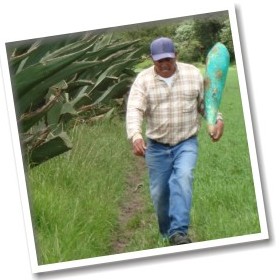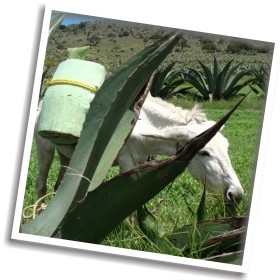|
Pulque Route "Drink of the Gods"
Pulque is a natural drink that is known in Mexico since pre-Hispanic
times, some say even the drink that is identified to Mexico should
be the Tequila Pulque and so invite you to know the great importance
the Maguey and pulque throughout history.
El Maguey, is a plant of the cactus family, means "Tree of Wonders",
and since pre was prized by the Indians who lived in the territory
now occupied by the states of Mexico, Hidalgo, Puebla and Tlaxcala ,
where the climate and altitude, is cultivated Maguey pulquero
Cultivation
El Maguey is planted on the shores of the land to prevent erosion of
farmland, reaches maturity between 8 and 12 years, when the Maguey
be used for the production of pulque, take away the heart to avoid
pencas continue coming to what farmers call "castrate the maguey"
then wait six months to form a kind of pot that will serve as a
warehouse to collect the juice that runs off the skin of the plant
delighting your sweet and fresh taste.
When not removed the heart of the maguey, grows a species of tree that grows up to 3 meters.
 High and at its highest, are its small yellow flowers, blooms only once in your life and then withers and dies.
High and at its highest, are its small yellow flowers, blooms only once in your life and then withers and dies.
Maguey products
-
Of the leaves is extracted mixiote, used for the preparation of
various dishes, in ancient times were made canvases with paint
mixiote codices; takes advantage known as sisal fiber for making
fabric, thread and cord, also used for livestock feed, the roof
of the houses as a roof and its sap helps wound healing
-
The Mead is the juice extracted from the plant for the
production of pulque, a Maguey has a production time of Mead 4-6
months and occurs between 10 and 16 liters. per day. The
tlachiquero is the name by which he is known to the person
lifting the mead, maguey goes to morning and afternoon, are the
three inseparable companions: the acocote, used to suck the
liquid from the plant the chestnut honey for depositing water
rising in each maguey, and a burrito for charging.
-
Mead also obtained Honey honey known as maguey. El Maguey has
two worm pests that are edible and are worthy representatives of
the succulent dishes that were eaten in ancient times; white
grubs (maguey worms) and red worms (chinicuiles).
The Pulque
This is undoubtedly the most famous product and most historically
significant. In pre-Hispanic times was considered a sacred drink,
took the priests and the kings, the people only allowed at parties
and in moderation, because being drunk was even considered a crime
punishable by death.
It was during the colony when it released its consumption, even
drunk, was not considered a sin. Pulque large revenues accounted for
the Spanish crown, they charged a tax on pulque barrels arriving in
Mexico City since the year 1784 for preventing the consequences of
alcoholism, prohibited people to stay a long time in the pulque ,
which were the places destined for the consumption of pulque, so
they had ads saying "they enter, go drinking, go pay, go out."
In the late nineteenth century, farmers who cultivated maguey
obtained higher profits thanks to the railroad, which pulque barrels
moved more quickly to large cities for consumption. They won so much
money from the sale of pulque which were known as the "Aristocracy
pulque".
It is now known that this Mexicanísimo beverage contains: water,
ethyl alcohol, sugars, albuminoid substances, thiamine, riboflavin,
niacin, vitamin C, protein and minerals (phosphorus, carbonates,
sulfates, chlorides, calcium, sodium, potassium, magnesium and iron).
When the pulque is in good condition, is energetic, diuretic, good
for diabetes, for anemia and gastrointestinal diseases. Improved
breastfeeding, serves as a caustic to clean the wounds, blood and
heated further refreshes.
The Tinacal
It takes the place of the mead, is deposited in basins where
microorganisms transform their sugar into alcohol and so Pulque is
obtained. When charge is known as a steward and is responsible for
feeding the vats with mead arriving every day. Traditionally in all
tinacales there an altar to the Holy Cross and the morning was
singing the praise to the Holy Trinity to Pulque, as a sign of
respect and reverence for this drink.
The development of pulque is delicate, is said to stop growing by
excess mead, that sucks or is cut by poor hygiene in its production,
even, that the rarefied air alters the taste of pulque and so on
some tinacales was refused entry to women wearing perfume.
The Pulquerías
These are the places where you drink pulque and sold in the early
twentieth century there were more than a thousand pulque in Mexico
City They are characterized by their picaresque names written on the
front and large signs decorated with murals of landscapes
campiranos.
Inside the pulque had a division for women to come in for pulque,
the floor was covered with sawdust and ceiling hung colored confetti.
 In some pulque, also offered snacks as enchiladas, gorditas,
memelas, pork, beans and a variety of salsas with tortilla griddle.
In some pulque, also offered snacks as enchiladas, gorditas,
memelas, pork, beans and a variety of salsas with tortilla griddle.
There are two ways to drink Pulque: The first to leave the tinacal
natural, and the second curing, which is to add some fruit to pulque
so becomes; curing pineapple, strawberry, pine, walnut, tomato,
lemon, etc.
Current Situation
Unfortunately, with the rise of empires brewers early twentieth
century and the decline of the estates after the revolution,
originated the beginning of the demise of pulque, also begins a
smear campaign, saying that pulque is a consuming only drink dirty
poor people. Thus, as in the fields begin to grow barley instead of
Maguey and people consume more beer than pulque.
Now there is less and less land tlachiqueros cultivation of maguey
putting endangered, but also has attracted the attention of the
younger generation to know the myth of Pulque "The drink of the
Gods". And those who are lovers of Maguey and pulque drinkers, we
are committed to disseminating and invite the world to know the
truth of this wonderful plant, which has provided shelter and
sustenance to the Mexicans of all time.
|





 High and at its highest, are its small yellow flowers, blooms only once in your life and then withers and dies.
High and at its highest, are its small yellow flowers, blooms only once in your life and then withers and dies.
 In some pulque, also offered snacks as enchiladas, gorditas,
memelas, pork, beans and a variety of salsas with tortilla griddle.
In some pulque, also offered snacks as enchiladas, gorditas,
memelas, pork, beans and a variety of salsas with tortilla griddle.